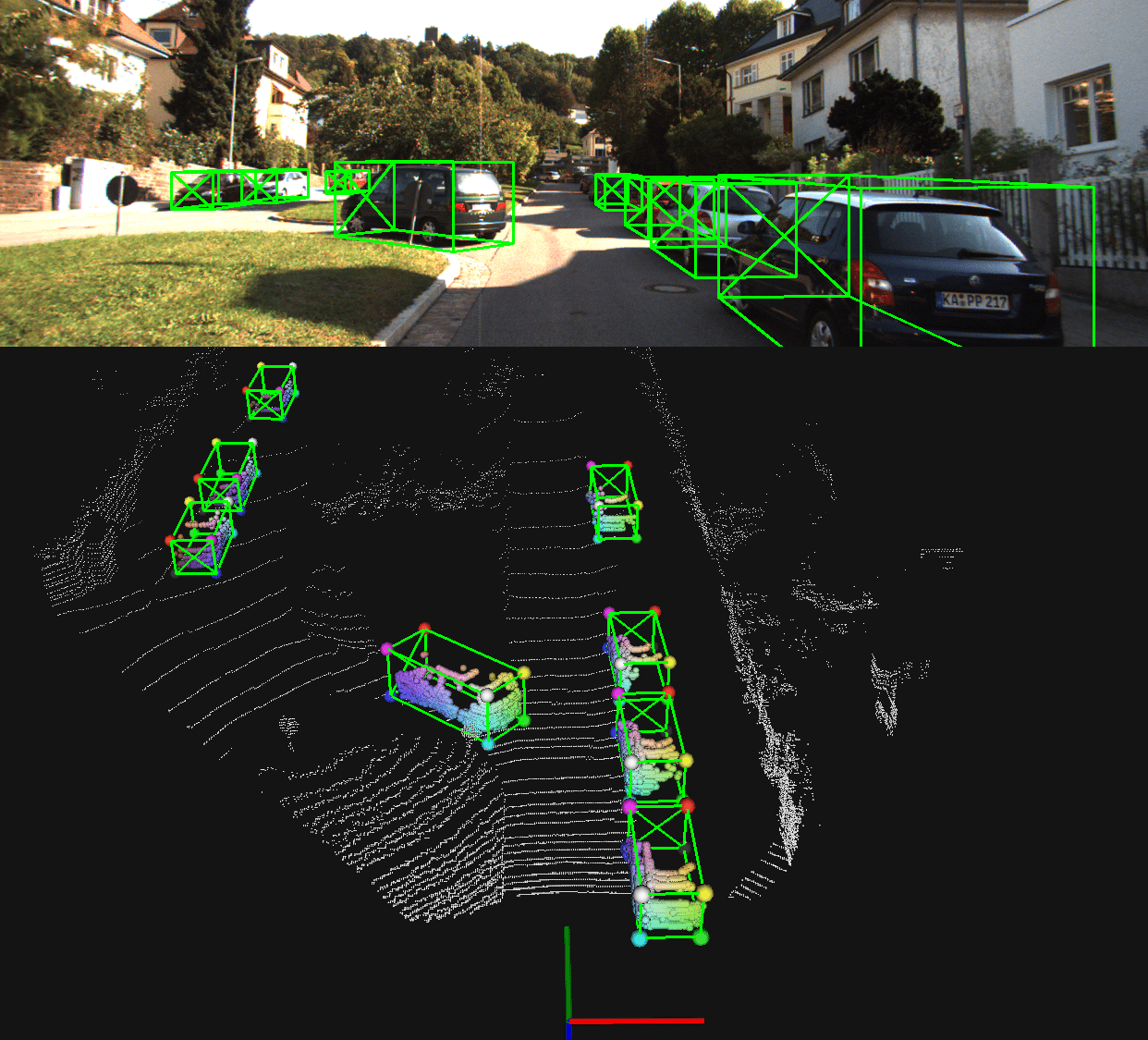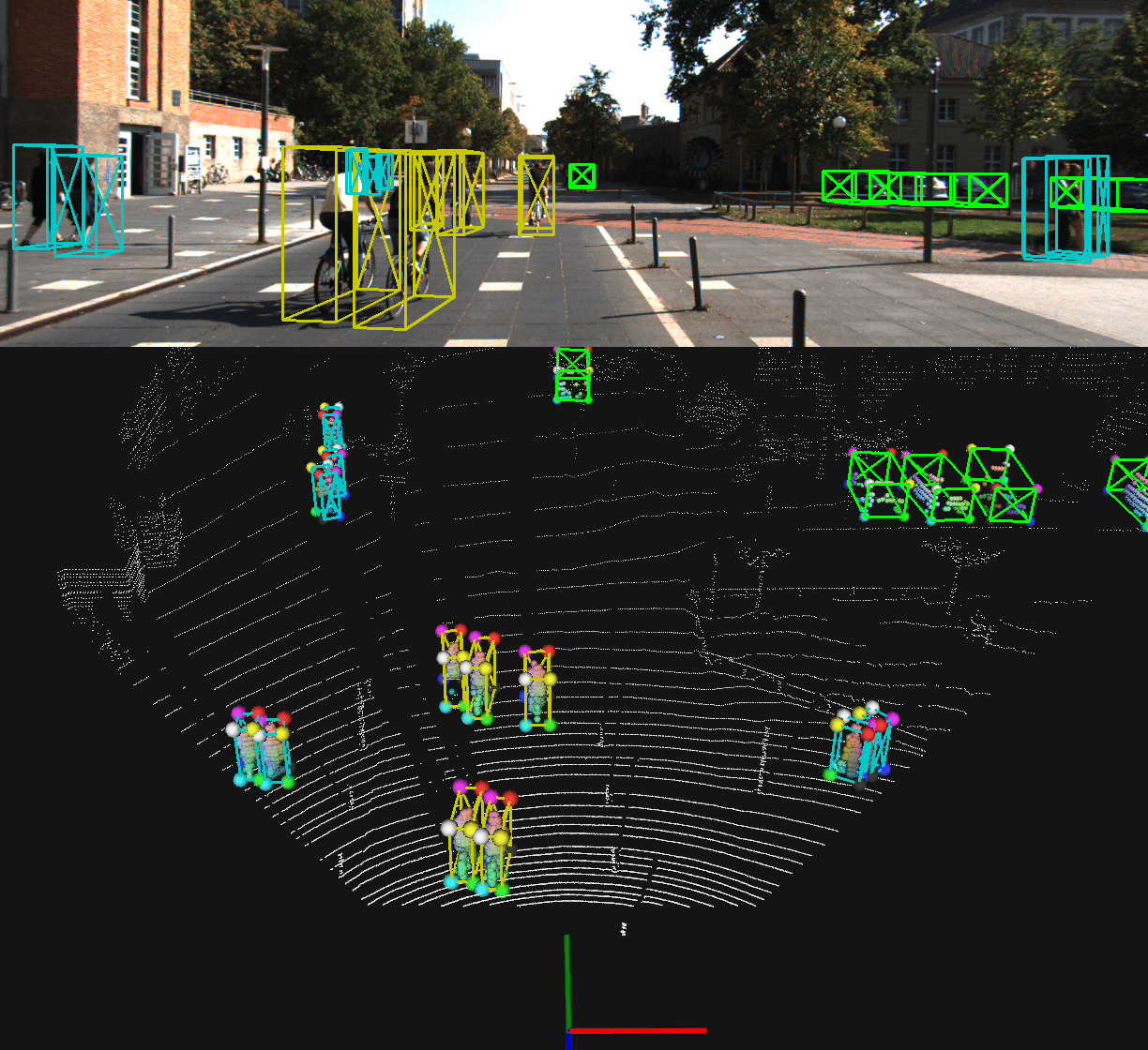PointCloudDet3D is a general PyTorch-based codebase for 3D object detection from point cloud.
PointCloudDet3D is a general PyTorch-based codebase for 3D object detection from point cloud.
It currently supports several state-of-the-art 3D object detection methods (PointPillar, SECOND, Part-A^2 Net) with highly refactored codes for both one-stage and two-stage frameworks.
This is also the official code release of Part-A^2 net.
Note that currently this framework mainly contains the voxel-based approaches and we are going to support more point-based approaches in the future.
- Support both one-stage and two-stage 3D object detection frameworks
- Distributed training with multiple GPUs and multiple machines, cost about 5 hours to achieve SoTA results on KITTI
- Clear code structure for supporting more datasets and approaches
- RoI-aware point cloud pooling
- GPU version 3D IoU calculation and rotated NMS
Supported methods are shown in the below table. The results are the 3D detection performance of car class on the val set of KITTI dataset. All models are trained with 8 GPUs and are available for download.
| training time | AP_Easy | AP_Mod. | AP_Hard | download | |
|---|---|---|---|---|---|
| PointPillar | ~2hours | 87.37 | 77.30 | 74.02 | model-18M |
| SECOND | ~2hours | 88.46 | 78.46 | 76.63 | model-20M |
| Part-A^2 | ~5hours | 89.66 | 79.45 | 78.80 | model-209M |
| Part-A^2-fc | ~5hours | 89.57 | 79.31 | 78.61 | model-244M |
All the codes are tested in the following environment:
- Linux (tested on Ubuntu 14.04/16.04)
- Python 3.6+
- PyTorch 1.1 or higher
- CUDA 9.0 or higher
- Clone this repository.
git clone https://github.com/sshaoshuai/PointCloudDet3D.git- Install the dependent libraries as follows:
- Install the dependent python libraries:
pip install -r requirements.txt
- Install the SparseConv library, we use the non-official implementation from
spconv. Note that we use an old version ofspconv, make sure you install thespconv v1.0(commit 8da6f96) instead of the latest one.
- Install this
pcdetlibrary by running the following command:
python setup.py developCurrently we only support KITTI dataset, and contributions are welcomed to support more datasets.
- Please download the official KITTI 3D object detection dataset and organize the downloaded files as follows (the road planes could be downloaded from here, which are optional for data augmentation in the training):
PointCloudDet3D
├── data
│ ├── kitti
│ │ │──ImageSets
│ │ │──training
│ │ │ ├──calib & velodyne & label_2 & image_2 & (optional: planes)
│ │ │──testing
│ │ │ ├──calib & velodyne & image_2
├── pcdet
├── tools
- Generate the data infos by running the following command in the path
pcdet/datasets/kitti:
python kitti_dataset.py create_kitti_infosAll the config files are within tools/cfgs/.
- Test with a pretrained model:
python test.py --cfg_file ${CONFIG_FILE} --batch_size 4 --ckpt ${CKPT}- For example, for testing with the above provided
Part-A^2model, please run the following command (here we add--setto modify some default parameters to match with the training setting of the providedPart-A^2model, and other provided models do not need to add it):
python test.py --cfg_file cfgs/PartA2_car.yaml --batch_size 4 --ckpt PartA2.pth \
--set MODEL.RPN.BACKBONE.NAME UNetV0 MODEL.RPN.RPN_HEAD.ARGS use_binary_dir_classifier:True- To evaluate all the saved checkpoints of a specific training setting and draw the performance curve on the Tensorboard, add the
--eval_allargument:
python test.py --cfg_file ${CONFIG_FILE} --batch_size 4 --eval_allCurrently, to train PointPillar or SECOND or PartA2, the --batch_size depends on the number of your training GPUs as we use ${BATCH_SIZE}=4*${NUM_GPUS}, i.e., --batch_size 32 for training with 8 GPUs.
- Train with multiple GPUs:
sh scripts/dist_train.sh ${NUM_GPUS} \
--cfg_file ${CONFIG_FILE} --batch_size ${BATCH_SIZE}- Train with multiple machines:
sh scripts/slurm_train.sh ${PARTITION} ${JOB_NAME} ${NUM_GPUS} \
--cfg_file ${CONFIG_FILE} --batch_size ${BATCH_SIZE}- Train with a single GPU:
python train.py --cfg_file ${CONFIG_FILE} --batch_size ${BATCH_SIZE} We would like to thank for second.pytorch for providing the original implementation of the one-stage voxel-based framework, and there are also some parts of the codes that are modified from PointRCNN.
We hope that this repo could serve as a strong and flexible codebase to benefit the research community by speeding up the process of reimplementing previous works and/or developing new methods.
If you find this work useful in your research, please consider cite:
@article{shi2020points,
title={From Points to Parts: 3D Object Detection from Point Cloud with Part-aware and Part-aggregation Network},
author={Shi, Shaoshuai and Wang, Zhe and Shi, Jianping and Wang, Xiaogang and Li, Hongsheng},
journal={IEEE Transactions on Pattern Analysis and Machine Intelligence},
year={2020},
publisher={IEEE}
}
and / or
@inproceedings{shi2019pointrcnn,
title={PointRCNN: 3d Object Progposal Generation and Detection from Point Cloud},
author={Shi, Shaoshuai and Wang, Xiaogang and Li, Hongsheng},
booktitle={Proceedings of the IEEE Conference on Computer Vision and Pattern Recognition},
pages={770--779},
year={2019}
}
Should you have any question, please contact Shaoshuai Shi (@sshaoshuai).

